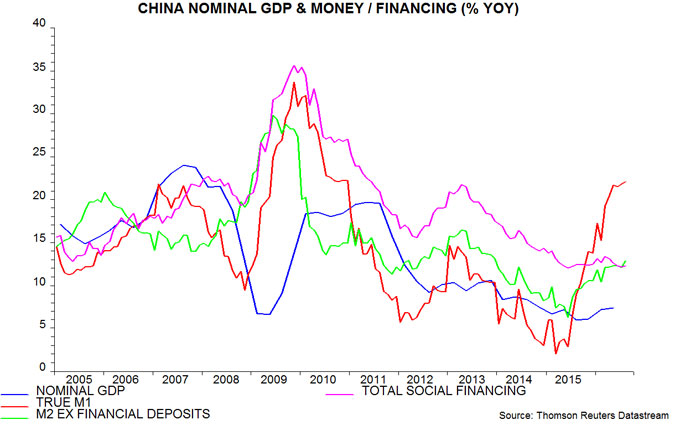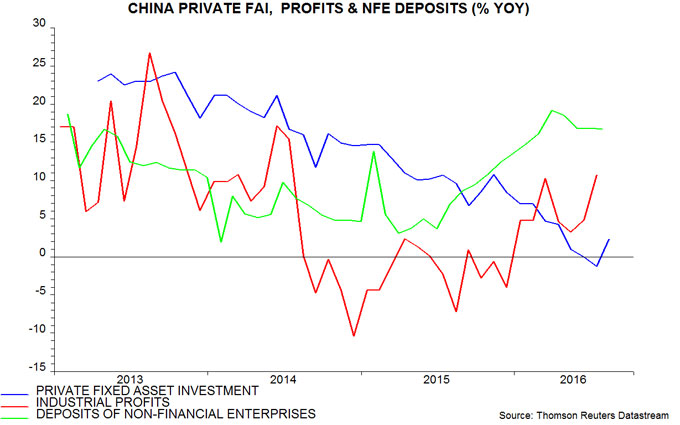Entries from September 11, 2016 - September 17, 2016
UK note data suggesting continued retail strength
UK retail sales surprised positively again in August, as had been suggested by data on notes and coin in circulation – see previous post. Weekly numbers on the note issue have strengthened further so far in September, hinting that high-street spending has remained firm.
Retail sales volume declined by only 0.2% in August after an upwardly-revised 1.9% gain in July. Annual growth was stable at 6.2%. Continued strength had been suggested by buoyant annual growth of real (i.e. consumer price inflation-adjusted) notes and coin – see first chart.
Currency in circulation appears to have accelerated further in early September. Annual growth of the note issue averaged 9.7% in the first two weeks, up from 8.8% in August – second chart.
Retail sales volume feeds into the output measure of GDP with a 5.6% weight. If September sales were to equal the July / August average, the third-quarter rise would be 1.5%, implying a 0.1 percentage point contribution to GDP growth. As noted in yesterday’s post, vacancies numbers are consistent with quarterly GDP expansion of 0.4%. The Bank of England has revised its third-quarter growth forecast from 0.1% to 0.3% and may be forced to upgrade further.
Chinese money trends still strengthening
Chinese monetary trends continue to give an unambiguously positive message for near-term economic prospects.
The preferred narrow and broad money measures here are “true” M1 and M2 excluding financial deposits. True M1 includes household demand / temporary deposits, which are omitted from the official M1 aggregate. Financial deposits within M2 are volatile and appear unrelated to current or prospective economic developments.
Annual growth of true M1 rose to 22.1% in August, with M2 ex financial deposits expansion up to 12.8% – the fastest since 2011 and 2013 respectively. The continued upswing signals further nominal GDP acceleration over coming quarters – see first chart.

The second chart shows six-month changes in industrial output and real true M1 / M2 ex financial deposits (i.e. deflated by consumer prices). The real money growth measures had moderated from late 2015 / early 2016 peaks but shot up again in August, reaching new highs – second chart.

Some recent commentary has claimed, bizarrely, that the large gap between narrow and broad money growth is a negative signal for economic prospects. There is no theoretical or empirical basis for this view. Money held in narrow form is more likely to be spent. The gap was last similarly large in 2010 ahead of a sustained period of strong economic growth. G7 evidence confirms that changes in the gap are positively, not negatively, correlated with future growth.
The size of the gap is of much less significance than the fact that both narrow and broad money are accelerating, in both nominal and real terms.
Another claim is that economic recovery has been achieved at the expense of unsustainable credit expansion. Annual growth of total social financing (TSF) of 12.3% in August, however, was barely above a multi-year low of 12.0% reached in June 2015 – third chart. TSF continues to outpace nominal GDP expansion by a wide margin but the gap is likely to narrow. The TSF / GDP ratio will reach a limit at some point but when and at what level are unknowable.

UK vacancies data suggesting Q3 economic resilience
The working assumption here has been that the immediate growth hit from the Brexit vote shock would be modest, reflecting supportive monetary trends and an improving global economic environment. A previous post argued for ignoring the high-profile but unreliable purchasing managers’ surveys and focusing on official labour market data – particularly vacancies numbers – to assess the validity of this assumption.
New data this morning support the baseline view. The stock of vacancies actually rose in the three months to August from the previous three months, partially reversing a fall in early 2016. The latest three-month change is consistent with quarterly GDP / gross value added (GVA) growth of about 0.4% – see first chart.
Claimant-count unemployment numbers were also reassuring, though are judged here to be less significant – vacancies are a coincident indicator of economic activity while the claimant count usually responds with a short lag. The number of claimants was unchanged in August from three months before, again suggesting quarterly GDP / GVA expansion of 0.4% – second chart.
July services turnover numbers due for release on 19 September will provide more clues on current-quarter growth.


Chinese growth pick-up on track
Better Chinese activity data for August support the view that the economy is gaining momentum – contrary to the consensus forecast of a second-half slowdown. Firmer growth had been signalled by narrow money trends (allowing for the usual lag) and the OECD’s leading indicator.
Annual industrial output growth rose from 6.0% in July to 6.3% in August, the fastest since June 2015 excepting March’s 6.8%, which was artificially boosted by a New Year timing effect. The August result may have benefited from catch-up production after disruptions caused by bad weather in July, as well as more working days. However, there was an offsetting downward distortion from factory closures around Hangzhou to improve air quality ahead of the recent G20 meeting.
Economic concerns have focused on private-sector investment, which contracted in nominal terms in July compared with a year earlier. Previous posts argued that this weakness reflected a lagged response to falling profits in 2014-15; with profits reviving in early 2016, and money holdings of enterprises rising strongly, a second-half recovery in investment was expected. The annual change rebounded to +2.3% in August – see chart.
Profits are being lifted by rising producer prices, which increased again in August – the fifth gain in the last six months.
Annual growth in retail sales, meanwhile, strengthened from 10.2% in July to 10.6% in August, or 9.6% allowing for consumer goods inflation of 0.9%. Auto sales were particularly strong, rising by an annual 13.1%, probably partly reflecting the approaching (year-end) expiry of tax incentives – sales growth is likely to weaken sharply in early 2017.
The OECD’s leading indicator strengthened further in July – see previous post. August monetary data later this week will provide clues about the sustainability of the current upswing beyond early 2017.




